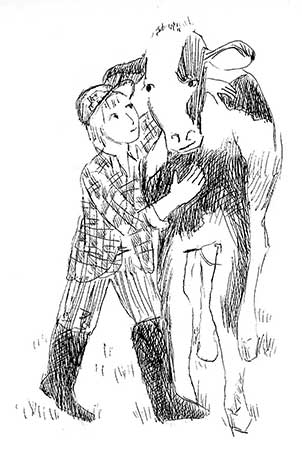 |
| Toki Oshima illustration |
The decision to switch from hand to machine milking
By Jacki M. Perkins
Recently a question on a listserv for beginning farmers piqued my interest. When and why have any of you switched from hand milking to a machine?”
Having grown up milking cows commercially, been formally educated in dairying, then switching to a family cow when life took me from the family farm, I have formed my own opinions on the matter. I readily admit that some perspectives have eluded me thus far in my admittedly short life, so the opportunity to “talk cow” with a group of like-minded people was … exciting.
Milking by Hand
We can make the case that having one or two lactating animals is grounds for hand milking. The costs are lower due to lack of machinery, maintenance thereof, energy used and infrastructure needed. Time management plays a role. Many find that washing and monitoring equipment takes as much as or more time than actually hand milking the animals. The simplicity of prepping udders, milking into a bucket and pouring the milk through a simple filter into a cooling vat is alluringly quick. Individuals in this camp also find solace in the quiet solitude they can find while leaning into a warm and contented body as she graciously shares her bounty with the family.
Some simple management tools can make this task more fruitful and enjoyable. First select a species or breed that meets your needs and personality. Entering into battle every day is neither fruitful nor enjoyable.
Then consider milking only once a day when you know you have the time. You can do this by using one or more offspring to help keep the ladies milked out completely. This will save wear and tear on your hands and will provide several extra animals for sale. The timing of using young stock to consume some of the milk flow depends largely on your goals. If you want to make products other than fluid milk, consider using once-a-day milking, as the majority of the fat in milk is in the top of the udder. If you want a low-fat product or a fast-growing meat animal, milk out the animal first and let the young clear out the rest of the udder. In my experience, the saliva of a healthy calf seems to create a natural barrier much the way a teat dip would protect the open sphincter of the teat.
Minimizing grain intake is another management tool. If you choose low or no grain, be sure to provide for the mineral needs of lactating and pregnant animals.
If you prefer hand milking, control mastitis with good hand and udder sanitation. Keeping hands bacteria-free is virtually impossible due to the structure and surface area of fingerprints. If you suspect a case or cases of mastitis, milk infected animals last while wearing gloves to help stop the spread of disease both in animals and humans.
Milking by Machine
Sometimes milking by machine simply makes more sense than by hand. When the number of animals exceeds the time or energy allotted to the task, consider spending the money on an appropriate system.
Arthritis, a common ailment that comes with dignified age, also drives some people to use machines on smaller numbers of animals.
Teat length and udder health may factor into the decision to milk with machines. Short teats are hard to hold onto, especially when an animal is fresh and the udder is engorged.
Sheep and goat kids naturally suck at a faster rate than calves, and human hands are hard pressed to work at that speed. Having the correct pulsation speed on machines for sheep and goats can lead to better letdown and udder health of these animals.
You will need to maintain numerous items with a milking system. Pennsylvania State University Cooperative Extension has a free hour-long webinar on the maintenance checklist for milking systems. It outlines the schedule to follow to avoid issues with milk quality and animal health. Find the presentation at https://extension.psu.edu/milking-system-operation-and-maintenance-1?iwd_preview12345=1 or by searching the Penn State Extension website for “Milking System Operation and Maintenance.” Here is a simple list of the items that need to be monitored:
- Distribution/reserve tank
- Regulator
- Vacuum gauge
- Vacuum pump
- Pulsators
- Pulsator lines
- Filter to the pulsator lines
- Milking claws and inflations
- Milking lines
- Sanitary trap
- Receiver jar or bucket of a bucket milker
- Vacuum reserve capacity (determined through a “fall-off” test)
Also consider washing procedures and systems and what chemicals to use. Some systems require monitoring; others are automatic. Taking the whole system apart after every milking is impractical, so you need to use strong chemicals at the appropriate concentrations, water temperature, hardness and pH. Problems quickly arise if any one of these elements is off.
Whatever you choose, if you have further questions on milking systems or animal health in an organic setting, do not hesitate to contact MOFGA’s farm services. We’re always here to help.
Jacki M. Perkins is MOFGA’s organic dairy and livestock specialist. You can contact her at [email protected] or 802-595-9866.

